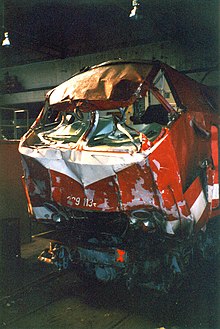Railway accident in Berlin-Wannsee
In the railway accident in Berlin-Wannsee on Good Friday , April 9, 1993, an InterCity and an express train collided head- on at Berlin-Wannsee station . Three people died. This was the worst railway accident in Berlin's post-war history.
Starting position
In the weeks preceding the accident, construction work took place on the Berlin – Blankenheim railway line . The section between Wannsee and the junction at Griebnitzsee was only open to traffic on several occasions. In the days before the accident, for example, the track from Wannsee to Griebnitzsee was closed, and the trains ran in this direction on the track in the opposite direction. However, due to the increased volume of traffic on Easter days , the blockage was lifted and normal operations continued.
The IC 995 Leo von Klenze , pulled by the diesel locomotive 229 113 , on the way from Berlin Hauptbahnhof (since 1998: Berlin Ostbahnhof ) to Stuttgart Hauptbahnhof , and the relief train D 10545, pulled by the diesel locomotive 218 267 from Hannover Hauptbahnhof to Berlin Zoologischer Garten , were scheduled to meet at Berlin Wannsee train station. There were around 1,300 passengers in both trains .
The accident was facilitated by the fact that the Berlin Hauptbahnhof – Griebnitzsee section was not yet equipped with compatible train radio at that time . The Deutsche Reichsbahn , responsible for railway operations in West Berlin , the Senate and the Deutsche Bundespost Berlin had not been able to agree on the allocation of radio frequencies . Although the locomotives involved and the signal box in Griebnitzsee were equipped with train radio at the time of the accident , the signal box in Wannsee was not.
the accident
Mistakenly put the dispatcher station Wannsee for the IC 995, the driveway one on the track the opposite direction. This incorrect route made it impossible for the exit signal to be set to travel. The dispatcher saw this as a disturbance and activated the replacement signal - the signal that he had used the most in the days before due to the construction work. The D 10545 was already on the released track in the opposite direction.
The locomotive driver of the IC did not notice this error, because he had not read the entries of the compilation of the temporary speed limits and other special features that were valid for this day .
The dispatcher in Wannsee recognized his mistake quickly, but could no longer stop the train because there was no radio link. The alerted dispatcher in Griebnitzsee could no longer stop the express train either. Although he asked the D 10545 by train radio to stop immediately, the train was already too far from Griebnitzsee to receive the radio message with the relatively insensitive Bundesbahn train radio. The IC engine driver, on the other hand, was further away from Griebnitzsee, but equipped with a more sensitive Reichsbahn train radio, heard the radio message, but could not classify it and therefore ignored it.
At around 2:30 p.m., the IC and the express train collided head -on at 63 and 40 km / h at a distance of 14.9 kilometers . The engineer of the IC headed when he saw the express right to a rapid braking and ran into the back of his locomotive. The two diesel locomotives, each weighing approx. 100 t, wedged into one another, the following passenger cars were compressed by the mass of the following trains to half their length.
consequences
Three people died: The 21-year-old train driver of the express train and his companion were so surprised by the oncoming IC that they could no longer react. They tried neither to brake quickly nor to get to safety and both died. In 1.- Class - Großraumwagen the IC a traveler died.
49 people were injured on both trains, 26 of them seriously, the driver of the express train so badly that his leg had to be amputated . The trainer's assistant on the IC was able to open the driver's cab door, was thrown out of the locomotive by the force of the collision and broke his arm. It took several hours before all the travelers trapped in the car could be freed.
Trivia
A passenger happened to photograph his train out of the window - and had the return train on the same track in the picture. The collision occurred immediately after the recording.
literature
- Erich Preuss : Journey to Doom . Stuttgart 1997, ISBN 3-613-71058-7 , p. 47 ff.
Web links
Individual evidence
- ↑ a b c d report of the Berlin fire brigade.
- ^ Train accident in Berlin: three dead. Abendblatt, April 10, 1993, archived from the original on July 28, 2014 ; Retrieved April 27, 2009 .
- ^ Journal Eisenbahn-Kurier , issue 7/1993, p. 7.
Coordinates: 52 ° 24 ′ 40.8 " N , 13 ° 9 ′ 23.3" E
